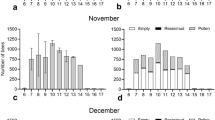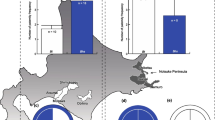Abstract
Nestmate recognition was studied in the polydomous antCataglyphis iberica (Formicinae) in the laboratory. The study examined six colonies collected from two different populations 600 km apart in the Iberian peninsula (Barcelona and Murcia). Introduction of an alien worker into an allocolonial arena always ended in death to the intruder, demonstrating that in this species societies are extremely closed. Dyadic encounters composed of individuals from different colonies in a neutral arena confirmed the existence of high aggression between allocolonial individuals. We also investigated variability in the composition of the major cuticular hydrocarbons between the colonies used in the behaviorial tests. There were marked quantitative differences between the profiles of ants from the two populations, suggesting that the populations are completely segregated. Cuticular profiles within a population tended to be more similar, but were nevertheless colony specific. The degree of colony closure inC. iberica seemed to be independent of geographic distance since aggression between the colonies was always at its maximum, irrespective of their population origin.
Similar content being viewed by others
References
Bagnères, A.-G., andMorgan, E. D. 1991. The postpharyngeal glands and the cuticle of Formicidae contain the same characteristic hydrocarbons.Experientia 47:106–111.
Bagnères, A.-G., Errard, C., Mulheim, C., Joulie, C., andLange, C. 1991. Induced mimicry of colony odors in ants.J. Chem. Ecol. 17:1641–1664.
Benois, A. 1973. Incidences des facteurs écologiques sur le cycle annuel et l'activité saisonnière de la fourmi d'ArgentineIridomyrmex humilis (Mayr) (Hymenoptera, Formicidae), dans la région d'Antibes.Insectes Soc. 20:267–296.
Bonavita-Cougourdan, A., Clément, J.-L., andLange, C. 1987. Nestmate recognition: The role of cuticular hydrocarbons in the antCamponotus vagus Scop.J. Entomol. Sci. 22:1–10.
Bourke, A. F. G., andFranks, N. 1995. Social evolution in Ants. Princeton University Press, Princeton, New Jersey.
Breed, M. D., andBennett, B. 1987. Kin recognition in highly eusocial insects, pp. 243–286,in D. J. C. Flecher and C. D. Michener (eds.). Kin Recognition in Animals. John Wiley & Sons, New York.
Cagniant, H. 1976. Cycle biologique de la fourmiCataglyphis cursor Fonscolombe. Hymènoptères, Formicidae.Vie Milieu 26:277–281.
Cerdá, X. 1988. Food collection byCataglyphis iberica (Em.) (Hymenoptera, Formicidae).Ann. Zool. 41:515–524.
Cerdá, X., andRetana, J. 1988. Influencia de los factores ambientales sobre la actividad diaria de recoleccion de la hormigaCataglyphis iberica (EM.) (Hym: Formicidae).An. Biol. 15:75–82.
Cerdá, X., andRetana, J. 1992. A behavioural study of transporter workers inCataglyphis iberica ant colonies (Hymenoptera, Formicidae).Ethol. Ecol. Evol. 4:359–374.
Do Nascimento, N. R. R., Billen, J., andMorgan, E. D. 1993. The exocrine secretions of the jumping antHarpegnathos saltator.Comp. Biochem. Physiol. 104B:505–508.
Fielde, A. M. 1904. Power of recognition among ants.Biol. Bull. Mar. Biol. Lab. 7:227–250.
Henderson, G., Andersen, J. F., andPhillips, J. K. 1990. Internest aggression and identification of possible nestmate discrimination pheromones in polygynous antFormica montana.J. Chem. Ecol. 16:2217–2228.
Hölldobler, B., andWilson, E. O. 1977. The number of queens: An important trait in ant evolution.Naturwissenschaften 64:8–15.
Howard, R. W. 1993. Cuticular hydrocarbons and chemical communication, pp. 179–226,in D. W. Stanley-Samuelson and D. R. Nelson (eds.). Insect Lipids: Chemistry, Biochemistry and Biology, University of Nebraska Press, Lincoln.
Howse, P. E. 1975. Chemical defenses of ants, termites and other insects: some outstanding questions, pp. 23–40,in C. Noirot, P. E. Howse and G. Le Masne (eds.). Pheromones and Defensive Secretions in Social Insects. IUSSI, Dijon, France.
Jutsum, A. R., Saunders, T. S., andCherrett, J. M. 1979. Intraspecific aggression in the leafcutting antAcromyrmex octospinosus.Anim. Behav. 27:839–844.
Keller, L., andPassera, L. 1989. Influence of the number of queens on nestmate recognition and attractiveness of queens to workers in the Argentine antIridomyrmex humilis (Mayr).Anim. Behav. 37:733–740.
Lenoir, A., Querard, L., Pondicq, N., andBerton, F. 1988. Reproduction and dispersal in the antCataglyphis cursor (Hymenoptera, Formicidae).Psyche 95:21–44.
Lenoir, A., Francoeur, A., Errard, C., andJaisson, P. 1989. Résultats préliminaires sur le comportement deFormicoxenus provancheri en relation avec son hôteMyrmica incompleta (Hymenoptera, Formicidae).Actes Colloq. Insectes Soc. 5:225–232.
Lorenzi, M. C., Bagnères, A.-G., andClément, J.-L. 1996. The role of cuticular hydrocarbons in social insects: is it the same in paper-wasps? pp. 178–189,in S. Turilazzi and M. J. West-Eberhard (eds.). Natural History and Evolution of Paper-wasps. Oxford University Press, Oxford.
Markin, G. P. 1968. Nest relationship of the Argentine antIridomyrmex humilis (Hymenoptera: Formicidae).J. Kans. Entomol. Soc. 41:511–516.
Nowbahari, M., andLenoir, A. 1984. La fermeture des sociétés de la fourmiCataglyphis cursor; relations avec la distance géographique, pp. 457–461,in A. De Haro and X. Espadaler (eds.). Processus d'acquisition précoce. Les communications. Serv. Publ. Univ. Auton. Barcelona, SFECA, Bellaterra.
Nowbahari, E., Lenoir A., Clément, J.-L., Lange, C., Bagnères, A.-G., andJoulie, C. 1990. Individual, geographical and experimental variation of cuticular hydrocarbons of the antCataglyphis cursor (Hymenoptera: Formicidae): their use in nest and subspecies recognition.Biochem. Syst. Ecol. 18:63–73.
Obin, M. S. 1986. Nestmate recognition cues in laboratory and field colonies ofSolenopsis invicta Buren (Hymenoptera: Formicidae): Effect of environment and the role of cuticular hydrocarbons.J. Chem. Ecol. 12:1965–1975.
Obin, M. S., andVander Meer, R. K. 1988. Sources of nestmate recognition cues in the imported fire ant,Solenopsis invicta Buren (Hymenoptera: Formicidae).Anim. Behav. 36:1361–1370.
Provost, E. 1991. Nonnestmate kin recognition in the antLeptothorax lichtensteini: Evidence that genetic factors regulate colony recognition.Behav. Genet. 21:151–167.
Ross, K. G., Vander Meer, R. K., Fletcher, D. J. C., andVargo, E. L. 1987. Biochemical phenotypic and genetic studies of two introduced fire ants and their hybrid (Hymenoptera: Formicidae).Evolution 41:280–293.
Soroker, V., Vienne, C., andNowbahari, E., andHefetz, A. 1994. The postpharyngeal gland as a “gestalt” organ for nestmate recognition in the antCataglyphis niger.Naturwissenschaften 81:510–513.
Soroker, V., Vienne, C., andHefetz, A. 1995. Hydrocarbon dynamics within and between nestmates inCataglyphis niger (Hymenoptera: Formicidae).J. Chem. Ecol. 21:365–378.
Tinaut, A., andPlaza, J. L. 1989. Situacion taxonomica del géneroCataglyphis Förster, 1850 en la Peninsula Ibérica. I. Las especies del subgéneroCataglyphis Förster (Hym. Formicidae).Eos 65:189–199.
Traniello, J. F. A. 1982. Population structure and social organization in the primitive antAmblyopone pallipes (Hymenoptera: Formicidae).Psyche 89:65–80.
Vander Meer, R. K., Lofgren, C. S., andAlvarez, F. M. 1985. Biochemical evidence for hybridization in fire ants.Fla. Entomol. 68:501–506.
Author information
Authors and Affiliations
Rights and permissions
About this article
Cite this article
Dahbi, A., Cerdá, X., Hefetz, A. et al. Social closure, aggressive behavior, and cuticular hydrocarbon profiles in the polydomous antCataglyphis iberica (hymenoptera, Formicidae). J Chem Ecol 22, 2173–2186 (1996). https://doi.org/10.1007/BF02029538
Received:
Accepted:
Issue Date:
DOI: https://doi.org/10.1007/BF02029538




